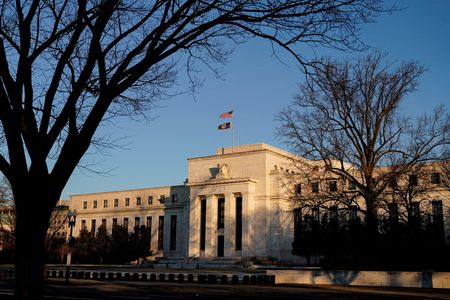A look at the day ahead in U.S. and global markets from Mike Dolan.
New year market optimism faces a series of critical tests over the remainder of this week as the first soundings of the year from the U.S. Federal Reserve cool any hopes for a major shift in policy emphasis there.
Fed chief Jerome Powell lays out his thoughts for the first time in 2023 later on Tuesday at a mega G10 central banking event hosted by Sweden’s Riksbank that includes the bosses of the Bank of Japan, Bank of England and Bank of Canada.
But Powell’s colleagues have already issued a shot across the bow to market pricing.
Although futures markets now expect Fed policy rates to peak below 5% by mid-year and drop up to half a point between then and year-end, two Fed policymakers speaking on Monday still saw rates moving above 5% and likely staying there for all of 2023.
San Francisco Fed President Mary Daly and Atlanta Fed chief Raphael Bostic said they expect Fed rates – now at 4.25% to 4.5% – will need to rise to a 5% to 5.25% range to sap inflation.
But both said Thursday’s U.S. consumer price report would be critical to whether the Fed decides on a quarter point increase at its upcoming meeting instead of the larger jumps it used for most of 2022. Bostic said further cooling of inflation meant he would have to take a quarter point increase “more seriously”.
Consensus forecasts are for headline CPI inflation to drop to 6.5% in December from 7.1% in November and for ‘core’ rates to fall back below 6%.
The combination of Powell’s appearance and the upcoming inflation readout held markets in check around the world on Tuesday, with European and Asian bourses and Wall St stock futures flat to negative. Ten-year U.S. Treasury yields firmed up from Monday’s three-week lows, with the dollar also steadying after hitting a seven-month trough.
Although there were encouraging signs of disinflation in Europe last week, the picture was less rosy in Japan – where markets suspect a tightening of Bank of Japan monetary policy may be in the offing this year.
Core consumer prices in Japan’s capital, a leading indicator of nationwide trends, rose a faster-than-expected 4.0% in December from a year earlier, exceeding the central bank’s 2% target for a seventh straight month and the fastest pace in four decades.
Optimism about China’s reopening has been a big factor in lifting world markets so far this year, but Beijing appears to be uncomfortable with the related rise of the yuan to five-month highs this week and the currency retreated today.
Investors should avoid Chinese currency risk and adapt to higher foreign exchange volatility, three state financial newspapers in Shanghai and Beijing said in front-page commentaries on Tuesday. The currency may have strengthened, but this year it would be volatile in both directions, they warned.
Since the newspapers delivered essentially the same message on the same day and on their front pages, they had almost certainly been directed to do so by the government.
The big political risk factor of the new year appeared to under control, meantime, and Brazil’s markets remained fairly resilient on Monday.
Far-right former Brazilian President Jair Bolsonaro was admitted to a hospital in Florida on Monday with stomach pains as 1,500 of his supporters were rounded up in Brasilia after storming key buildings in the capital over the weekend.
President Luiz Inacio Lula da Silva, who took office on Jan. 1 after defeating Bolsonaro in an October election, vowed to bring those responsible to justice and questioned why the army had not discouraged calls for a military coup outside their barracks.
The other big market obstacle of the week is the onset of the U.S. corporate earnings season.
U.S. banking giants are forecast to report lower fourth quarter profits this week as lenders stockpile rainy-day funds to prepare for an economic slowdown that is battering investment banking. Four American banking giants – JPMorgan, Bank of America, Citigroup and Wells Fargo – report earnings on Friday.
Along with Morgan Stanley and Goldman Sachs, they are the six largest lenders expected to amass a combined $5.7 billion in reserves to prepare for soured loans, according to average projections by Refinitiv. That is more than double the $2.37 billion set aside a year earlier.
Late on Monday, investment bank Jefferies reported a 52.5% decline in fourth-quarter profit, hit by lower underwriting fees and volatile markets that dented income from its trading desks. But the firm still posted its second-best year for investment banking revenue, substantially above 2019 levels, chief executive officer Richard Handler and president Brian Friedman said.
Diaried events and data releases that may provide direction to U.S. and world markets later on Tuesday:
* U.S. Dec NFIB small business survey. U.S. Treasury sells 3-year notes.
* U.S. Federal Reserve Chair Jerome Powell, Bank of Japan governor Haruhiko Kuroda, Bank of England Governor Andrew Bailey, Bank of Canada governor Tiff Macklem and European Central Bank board member Isabel Schnabel all speak at Swedish central bank event.
* U.S. corporate earnings: Bed Bath & Beyond, Albertsons
Graphic: US/Euro zone econ surprise gap https://fingfx.thomsonreuters.com/gfx/mkt/myvmogogbvr/One.PNG
Graphic: Tokyo core CPI at a new 40-year high https://www.reuters.com/graphics/JAPAN-ECONOMY/INFLATION/movakjnrrva/chart.png
Graphic: Brazil USD bond spreads steady after weekend violence https://www.reuters.com/graphics/BRAZIL-ECONOMY/FISCAL/gkplwxgzzvb/chart.png
Graphic: Big U.S. banks’ profits expected to plunge in Q4 https://www.reuters.com/graphics/USA-BANKS/dwvkdarqjpm/chart.png
(By Mike Dolan; Editing by Mark Potter; [email protected]. Twitter: @reutersMikeD)

